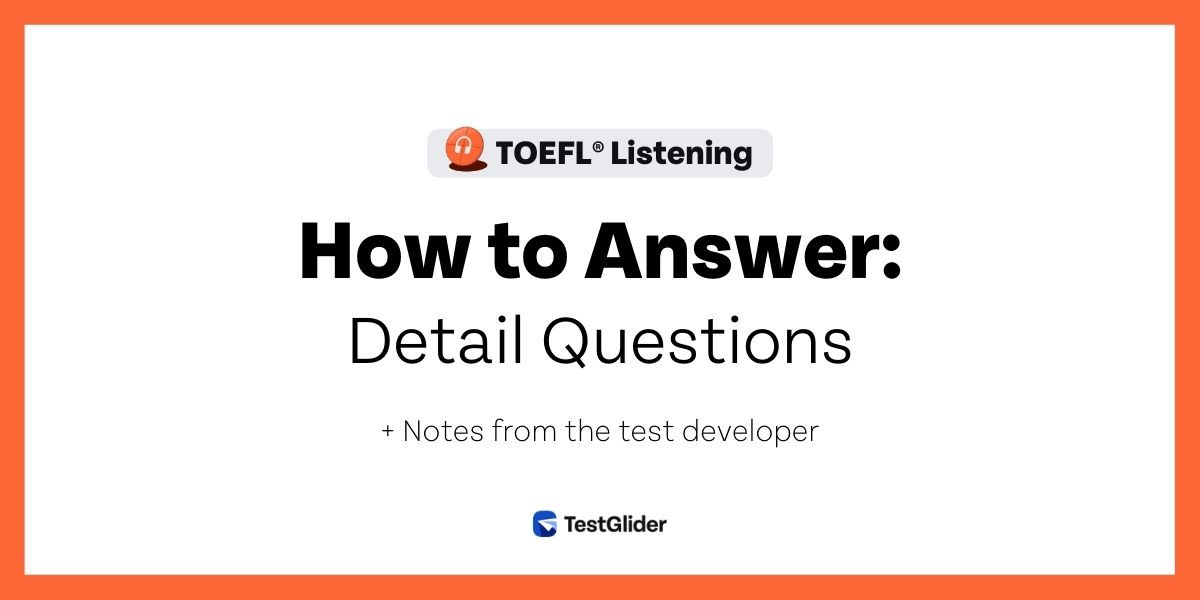1. Information about Detail Questions
TOEFL Listening Detail questions are very similar to the Factual Information questions in the Reading section. They ask test takers to identify specific facts from the lecture or conversation, although they are less likely to deal with trivial details like names or dates. Instead, they ask about important details that are related to the main idea. There are usually two or three Detail questions per passage. Detail questions are usually written as follows:
- According to the professor/student X …
- What/how/why/when/where did/is …
The answer choices may be written as complete sentences or phrases. The question may also be an incomplete sentence, and the correct answer choice will complete the statement with accurate information from the passage. There may also be two correct answers, in which case the question will say “Choose 2 answers.” and offer 5 answer choices.
2. Question Example
Here is an excerpt from a passage and its Detail question:
Professor
The Amber Road was not a single cohesive route, but an interconnected network of smaller trade routes that formed a central core that we now refer to as a road.
Male Student
Were the Amber Road and the Silk Road connected?
Professor
That is a bit more difficult to answer. Amber has a long history in Chinese folk medicine, and amber was exported from Myanmar to China in the past. However, infrared spectroscopy can identify the unique chemical structures of different kinds of amber, and it has been used to confirm that Baltic amber goods were transported all the way to China. They may have gotten there directly or indirectly, but exactly what path those items took is purely conjecture.
Q. According to the professor, how do archaeologists know that Baltic amber reached China?
(A) There are written records of transactions between merchants.
(B) Scientists can test amber to determine where it originated.
(C) The Amber Road and the Silk Road were directly connected.
(D) Amber was only mined in Northern Europe.
The correct answer is (B) because the professor said “However, infrared spectroscopy can identify the unique chemical structures of different kinds of amber, and it has been used to confirm that Baltic amber goods were transported all the way to China.”
(A) is incorrect because the professor doesn’t mention written records.
(C) is incorrect because the student asked if they were connected, but the professor said “They may have gotten there directly or indirectly, but exactly what path those items took is purely conjecture.”
(D) is incorrect because it contradicts the professor who said that “amber was exported from Myanmar to China in the past.”
3. Notes from the Test Developer
When writing Detail questions, all of the answer choices must contain information that was mentioned in the lecture or conversation, otherwise they do not make effective distractors. Some of them will make incorrect statements about information that was in the talk or directly contradict the passage, while others will correctly state information that was not mentioned.
For Detail questions, I often include a factual statement that includes information that was not mentioned in the passage. I also like to make distractors that include information from a student’s interruption but are incorrect, like answer choice (C) in the example. Detail questions are pretty straightforward to write and answer because they only deal with stated information.
4. Advice to Test Takers
I would advise test takers to do a few things when they need to solve a Detail question. First, keep in mind that all of the answer choices will include information from the talk, but only one will correctly state that information. Second, if you are unsure which answer is correct, use the process of elimination.
Some answer choices may be more obviously wrong than others and easier to rule out. So, look for any answers that present information that is incorrect or was not included in the talk. Finally, the answer choices are meant to be logical and plausible, so you may be unable to decide between two answer choices. In that case, guess.
Remember that you do not get points deducted for wrong answers in TOEFL. This is true for all questions so if you don’t know the answer or if you don’t have time to actually solve the question, guess. In addition, you will only get to hear the lecture or conversation once, but the answers will be presented in the talk in the same order as the questions. Therefore, I recommend that you read the questions before the recording starts and answer the questions as you listen to the lecture or conversation.
